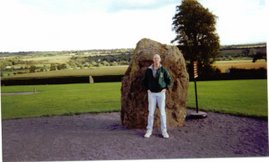Monday, March 12, 2007
Possible Prehistoric Indian Enclosure Uncovered in Indiana
Just to avoid signing off in an angry mood, I give you this story about a possible prehistoric enclosure that may have been built by Indians about 2,000 years ago. Yahoo News AP wire excerpt:
YORKTOWN, Ind. - A circular formation discovered in a wooded area next to a highway slated for widening is likely some sort of an earthen enclosure built by prehistoric Indians, Ball State University archaeologists say. Workers with the Delaware County Office of Geographic Information System found the earthen structure more than a year ago while studying contours on a large topographical map.
The circular formation on a wooded tract near Indiana 32 between Muncie and Yorktown was recently brought to the attention of the Indiana Department of Transportation, which plans to widen that segment of the highway to four or five lanes.
The 150-foot diameter feature was likely constructed by excavating a circular ditch around a space archaeologists call a central platform, said Ball State archaeologist Don Cochran. He said the structure is believed to be the work of prehistoric, Woodland Indians, although the property's owner has not permitted an examination of the site to determine its true origins.
Cochran said that aside from Mounds State Park, most of east-central Indiana's 300-plus known mounds and enclosures built by the Hopewell-Adena people about 2,000 years ago have been completely or partially destroyed by agriculture, development and artifact hunters. "It's absolutely critical we keep this one. This is one we don't know anything about," Cochran, who's the director of archaeological research at Ball State, told The Star Press.
Kyle Johnson, the county's GIS coordinator, and co-workers found the formation as they were reviewing a topographical map and noticed a near perfect circle. Johnson contacted the owner of the land, who agreed to meet GIS staff at the site more than a year ago. "It was like a big, round ditch," he recalled. "The owner didn't know anything about it. We went to Ball State, which seemed interested, but the owner wouldn't let them check it out."
Since then, the owner has sold the property to a new owner, who Cochran said has not given Ball State officials access to the land.
He said the structure is so prominent it shows up dramatically on Google Earth and resembles the aboriginal enclosures that are within Mounds State Park near Anderson.
Beth McCord, Ball State's assistant director of archaeological research, said it was surprising such a large suspected archaeological site was overlooked near a busy highway. If the site turns out to be an ancient Indian enclosure, she said it would be very rare example of its kind to have survived into modern times.
During my 2000 trip to Ireland, I took an afternoon to tour the famous megalithic sites Knowth and Newgrange (see photo). In addition to these giant mounds, there were dozens of other smaller ones in the surrounding fields. The guide told us that an average of three or four new ones are accidentally uncovered every year. It is amazing how much antiquity lies beneath our feet.
McCord said such earthen enclosures were probably gathering places for American Indians for ceremonies, dances and feasts during particular religious events, such as the winter solstice.
Full Story
It is a damned shame we don't have a more comprehensive history of the people who lived in this country long before Europeans settled. Thanks to people like the good folks at Ancient American, we are getting a bigger and better picture of what life was like thousands of years ago on this continent.
Subscribe to:
Post Comments (Atom)

No comments:
Post a Comment